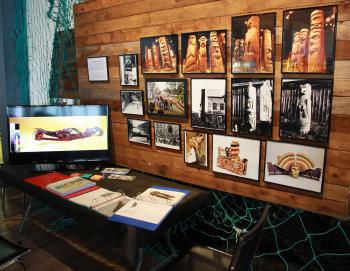Image Caption
Summary
Local Journalism Initiative Reporter
Windspeaker.com
For Tla-o-qui-aht artist Marika Swan, the journey of repatriating the cultural artifacts that belong to her community has been fraught with joy and sorrow.
Traveling to museums as far away as New York and Chicago on a grant that allows First Nations artists to research Indigenous art and artifacts, Swan says she was moved by the artistic quality and richness of history in the items she encountered.
“There are these incredible house posts from Opitsaht that are in the Chicago field museum on display and they are so beautiful. I send photos to people back home and they start crying... The sense of pride and the craftsmanship, it's just so beautiful,” she said.
“They are unbelievable treasures.”
Currently the project coordinator for the Living Archive, an independent project administered through the Carving on the Edge Festival Society, Swan works with the community to locate, research and properly identify thousands of Nuu-chah-nulth ancestral treasures and look into how they might be brought home. And work like hers may soon get a boost.
Last month, the BC Museums Association (BCMA) announced new provincial funding to help repatriation efforts like Swan's, with $500,000 going towards a variety of community grants aimed at different stages of the repatriation process. The latest funds follow a $2 million investment in repatriation efforts by the BC government over three years that went to the Royal BC Museum.
“As a sector we have lobbied to help insure that communities who want to engage in repatriation have the resources necessary to do [it],” says Jodi Simkin, president of the BCMA.
“Fundamentally this work is not new. Even when the $2 million was awarded, repatriation work really sits on the shoulders of generations of Indigenous leaders and community members and allies who have worked to help bring ancestors and artifacts back home.”
The process of formulating how the money is available will be decided by an Indigenous advisory committee to ensure it goes directly into community hands, said Simkin.
“We're really able to be quite broad in how we define that and respect that the government has given us that freedom to ensure that we can support as many communities as possible with the resources that we have.”
Though the funding represents a modest amount, the grants can be used for a variety of needs, from starting a non-profit or society, to general research or towards travel so community members can see items held in museums for themselves, she added.
The question of just how many of these items remain on display or stored in museum basements is still a mystery.
The Association on American Indian Affairs estimates that between one and two million artifacts and remains of ancestors are held in public collections, said Simkin, who is a member of their repatriation working group.
“That number is incredibly incomplete because it does not include any of the items that are held in private collections. I can't tell you how many pieces were taken in B.C. No one can tell you. We have no record. The government didn't have a centralized list when they raided potlatch, when they sold pieces, when they gave them away to other government agencies or to universities. Nobody knows,” she says.
In Swan's research she found the sheer volume of items meant narrowing her focus to just Nuu-chah-nulth culture. Even then, she says experts in the field estimated she was looking at close to a million artifacts scattered all over the world, including huge exhibits in Britain and Germany.
Another question she puzzled over was how often community members actually accessed any of these collections — or even knew they existed. In exploring this issue she was struck by the level of disconnection.
The closer a museum was to its community of origin the better the relationship, she says, but clearly more work needed to be done.
“We own our culture. And that is a shift we are just starting to recognize. Our culture belongs to us. Unequivocally. It is absolutely our intellectual property and it is up to communities how and what is shared,” says Swan.
“The museums who embrace that and are ready to give up control have an opportunity to build real relationships and potentially have much greater programming, because of the good work with communities that are willing to collaborate on things that they do want to share and they would like the public to know about.”
She said its not appropriate to have some items on display. “Different communities want different things and it's about supporting that process.”
Intake for the grants opens on Sept. 8, 2020. More details on how to apply will be available later this summer. More information on how to contact the BCMA is at http://museumsassn.bc.ca/repatriation-grants/

